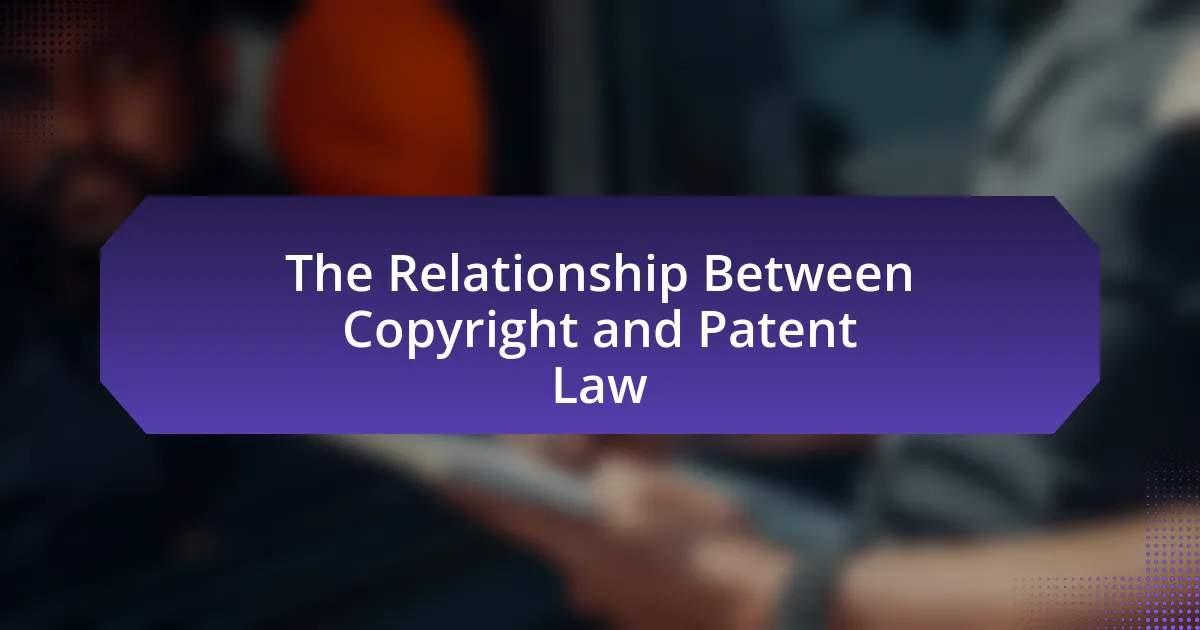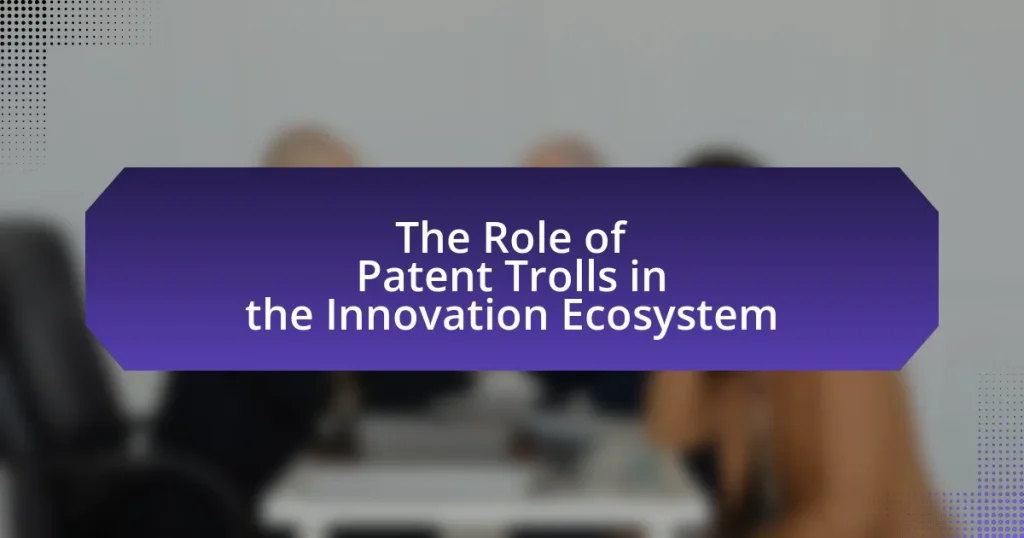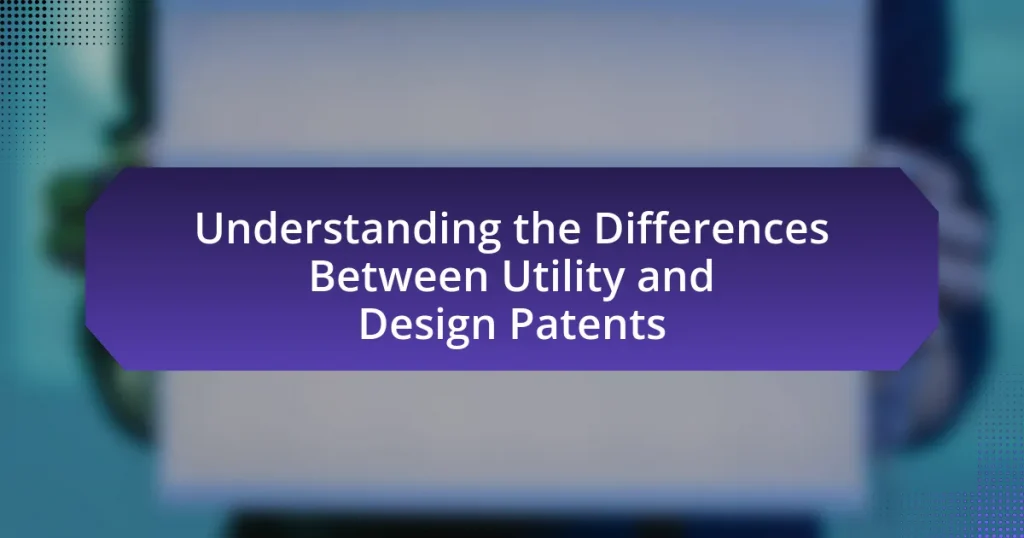The article examines the relationship between copyright and patent law, two distinct forms of intellectual property protection that serve different purposes. Copyright law safeguards original works of authorship, such as literature and art, while patent law protects inventions and processes that offer new solutions. The article outlines the differences in their objectives, the types of works and inventions eligible for protection, and the implications for creators and businesses. It also discusses the interaction between these legal frameworks, the challenges they present, and the importance of understanding both to navigate intellectual property rights effectively. Additionally, it highlights practical strategies for securing protections and resources available for further education on these laws.
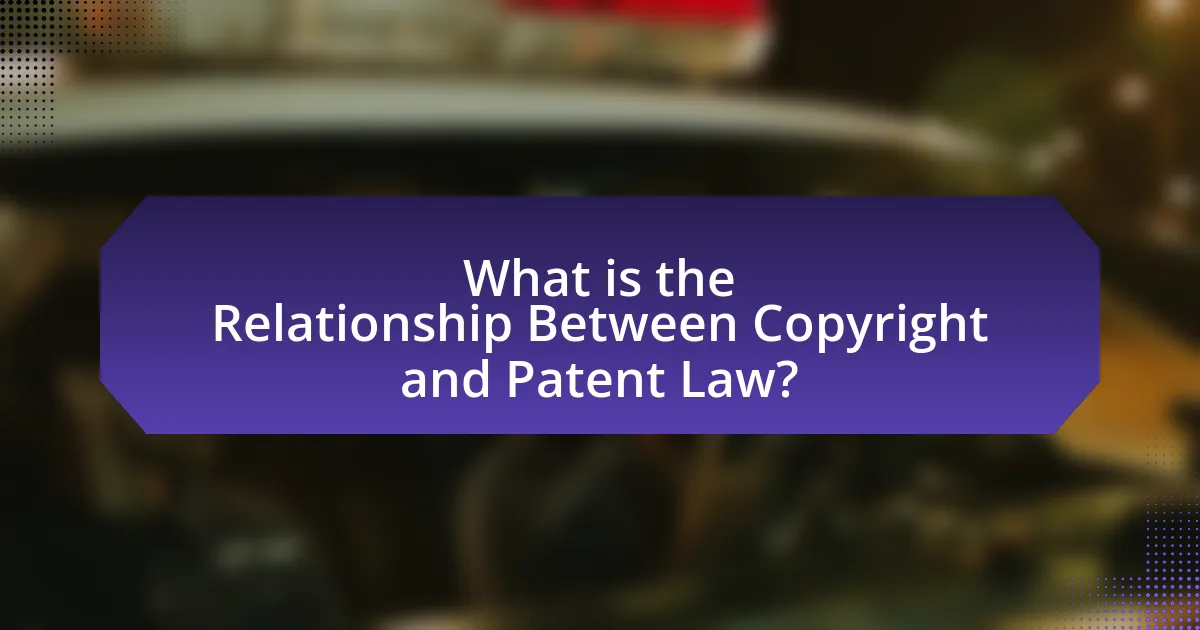
What is the Relationship Between Copyright and Patent Law?
Copyright and patent law are both forms of intellectual property protection, but they serve different purposes and protect different types of creations. Copyright law protects original works of authorship, such as literature, music, and art, while patent law protects inventions and processes that provide a new way of doing something or a new technical solution to a problem. The relationship between the two lies in their complementary roles in fostering innovation and creativity; for instance, a novel may be protected by copyright, while a unique device described within that novel could be eligible for patent protection. This distinction is crucial, as it allows creators to safeguard their artistic expressions and technological advancements simultaneously, promoting a balanced ecosystem for innovation.
How do copyright and patent law differ in their purposes?
Copyright law primarily aims to protect the expression of ideas in creative works, such as literature, music, and art, while patent law focuses on protecting inventions and processes that provide a new way of doing something. Copyright grants creators exclusive rights to reproduce, distribute, and display their works, thereby encouraging creativity and cultural development. In contrast, patents incentivize innovation by granting inventors exclusive rights to their inventions for a limited time, typically 20 years, which fosters technological advancement. The distinct purposes of these laws reflect their roles in promoting creativity and innovation within society.
What types of works are protected by copyright?
Copyright protects original works of authorship, including literary, musical, and artistic creations. This encompasses books, articles, music compositions, paintings, sculptures, films, software, and architectural designs. The U.S. Copyright Act of 1976 specifies that these works must be fixed in a tangible medium of expression to qualify for protection. Thus, any original work that is expressed in a physical form, whether written, recorded, or otherwise captured, is eligible for copyright protection.
What inventions are eligible for patent protection?
Inventions that are eligible for patent protection include new and useful processes, machines, articles of manufacture, and compositions of matter. According to the United States Patent and Trademark Office, an invention must meet specific criteria: it must be novel, non-obvious, and useful. For example, a new drug formulation or a unique manufacturing process can qualify for a patent if it demonstrates these characteristics. This eligibility is grounded in patent law, which aims to encourage innovation by granting inventors exclusive rights to their inventions for a limited time, thereby promoting advancements in technology and industry.
Why is understanding the relationship between copyright and patent law important?
Understanding the relationship between copyright and patent law is important because it helps individuals and businesses navigate intellectual property rights effectively. Copyright protects original works of authorship, such as literature and art, while patents protect inventions and processes. Recognizing how these two forms of protection interact can prevent legal conflicts and ensure that creators and inventors maximize their rights and benefits. For instance, a software developer may need to understand both copyright for the code and patent law for the underlying technology to safeguard their innovations comprehensively. This understanding is crucial in industries where both copyrights and patents are prevalent, such as technology and entertainment, to foster innovation while respecting existing rights.
How do these laws impact creators and inventors?
Copyright and patent laws significantly impact creators and inventors by providing legal protection for their original works and inventions, thereby incentivizing innovation and creativity. These laws grant exclusive rights to creators and inventors, allowing them to control the use and distribution of their intellectual property. For instance, copyright protects artistic and literary works, while patents safeguard inventions and processes, ensuring that creators can monetize their efforts without fear of unauthorized use. According to the U.S. Patent and Trademark Office, patents can increase the market value of inventions, encouraging investment in research and development. This legal framework fosters an environment where creators and inventors can thrive, ultimately contributing to economic growth and technological advancement.
What are the implications for businesses operating in creative industries?
Businesses operating in creative industries face significant implications related to copyright and patent law, primarily concerning intellectual property protection. These businesses must navigate complex legal frameworks to safeguard their creative works, such as music, art, and literature, which are protected under copyright law. For instance, the U.S. Copyright Office reports that copyright infringement can lead to substantial financial losses, emphasizing the need for robust legal strategies to protect original content. Additionally, businesses may also consider patent law for innovative processes or products, which can provide a competitive edge in the market. The interplay between these two forms of intellectual property can influence business strategies, investment in innovation, and overall market positioning, as companies must balance the costs of legal compliance with the potential for revenue generation from their creative outputs.
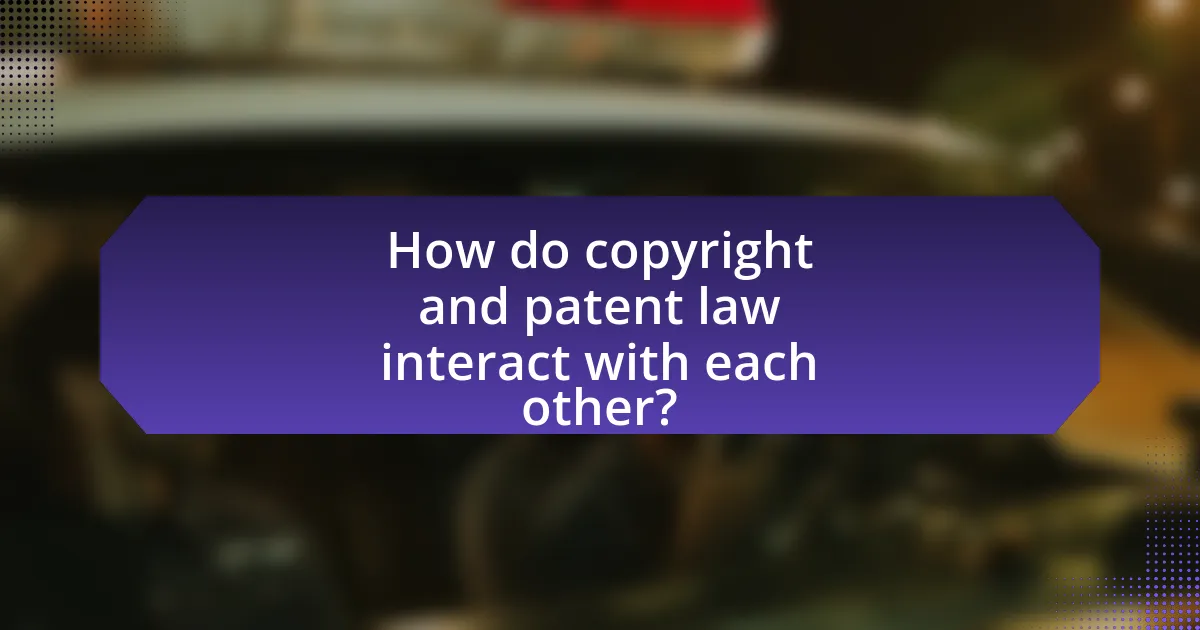
How do copyright and patent law interact with each other?
Copyright and patent law interact by protecting different aspects of intellectual property; copyright safeguards original works of authorship, while patents protect inventions and processes. Copyright applies to creative expressions such as literature, music, and art, granting exclusive rights to creators for a limited time, typically the life of the author plus 70 years. In contrast, patents provide exclusive rights to inventors for a period of 20 years from the filing date, covering new inventions or significant improvements to existing ones.
The interaction occurs when a work may be eligible for both protections; for example, a software program can be copyrighted as a literary work while also being patentable if it includes a novel algorithm. This dual protection allows creators to secure their rights in multiple ways, but it also requires careful navigation of both legal frameworks to avoid infringement. The U.S. Constitution and various statutes, such as the Copyright Act of 1976 and the Patent Act of 1952, establish these distinct yet complementary protections, ensuring that both creative and inventive contributions are legally recognized and safeguarded.
What are the overlaps between copyright and patent law?
Copyright and patent law overlap primarily in their protection of intellectual property, specifically in how they safeguard creative works and inventions. Both legal frameworks aim to incentivize innovation and creativity by granting exclusive rights to creators and inventors. For instance, copyright protects original works of authorship, such as literature, music, and art, while patents protect inventions and processes that provide a new way of doing something or a new technical solution. Additionally, both copyright and patent law require a formal application process for enforcement, and both can coexist in certain scenarios, such as software that may be protected by copyright for its code and by patent law for its underlying processes. This dual protection illustrates the complementary nature of these two forms of intellectual property rights.
How can a single work be protected by both copyright and patent law?
A single work can be protected by both copyright and patent law when it contains elements that qualify for each type of protection. Copyright protects the expression of ideas, such as the specific text, music, or artwork, while patent law protects inventions or processes that are novel, non-obvious, and useful. For example, a software program can be copyrighted for its code and user interface design, while a unique algorithm or method used within that software may be patentable if it meets the criteria for patent protection. This dual protection allows creators to safeguard both the creative expression and the functional aspects of their work, as established by the U.S. Copyright Act and the Patent Act.
What challenges arise from the intersection of these two legal frameworks?
The challenges arising from the intersection of copyright and patent law include the potential for overlapping protections, which can create confusion regarding rights and enforcement. For instance, a single innovation may be eligible for both copyright protection (for its expression) and patent protection (for its functional aspects), leading to disputes over which law applies and how rights are enforced. Additionally, the differing durations of protection—copyright typically lasting the life of the author plus 70 years, while patents last for 20 years—can complicate licensing agreements and the commercialization of creative works. This complexity can hinder innovation, as creators may face uncertainty about their rights and the scope of protection, ultimately affecting their willingness to invest in new projects.
How do courts interpret the relationship between copyright and patent law?
Courts interpret the relationship between copyright and patent law as distinct yet complementary forms of intellectual property protection. Copyright protects original works of authorship, such as literature and art, while patent law safeguards inventions and processes. Courts have established that these two forms of protection can coexist, as seen in cases like Baker v. Selden, where the U.S. Supreme Court ruled that copyright does not extend to the functional aspects of a work that are covered by patent law. This interpretation underscores the principle that while both copyright and patent law aim to promote innovation and creativity, they serve different purposes and protect different types of intellectual property.
What landmark cases have shaped this relationship?
Landmark cases that have shaped the relationship between copyright and patent law include the Supreme Court case of “Eldred v. Ashcroft” (2003), which upheld the constitutionality of the Copyright Term Extension Act, reinforcing the idea that copyright and patent laws serve different purposes but can coexist. Another significant case is “Feist Publications, Inc. v. Rural Telephone Service Co.” (1991), which clarified the originality requirement for copyright protection, impacting how creative works are distinguished from patentable inventions. Additionally, “Baker v. Selden” (1879) established that copyright does not protect ideas or methods, emphasizing the distinction between copyright and patentable subject matter. These cases collectively illustrate the evolving legal landscape that governs the interplay between copyright and patent law.
How do judicial interpretations affect the rights of creators and inventors?
Judicial interpretations significantly shape the rights of creators and inventors by clarifying and defining the scope of copyright and patent laws. Courts interpret legal texts, which can lead to changes in how rights are enforced, such as determining the originality required for copyright protection or the novelty needed for patent eligibility. For instance, the U.S. Supreme Court’s decision in the case of Alice Corp. v. CLS Bank International (2014) established a stricter standard for patent eligibility, impacting software and business method patents. This interpretation limited the scope of what can be patented, thereby affecting inventors’ rights to protect their innovations. Similarly, judicial rulings on fair use can influence creators’ rights by defining the boundaries of permissible use of copyrighted material, as seen in the case of Campbell v. Acuff-Rose Music, Inc. (1994), which clarified the transformative use standard. These interpretations directly affect the ability of creators and inventors to secure and enforce their rights, ultimately influencing their economic interests and the innovation landscape.
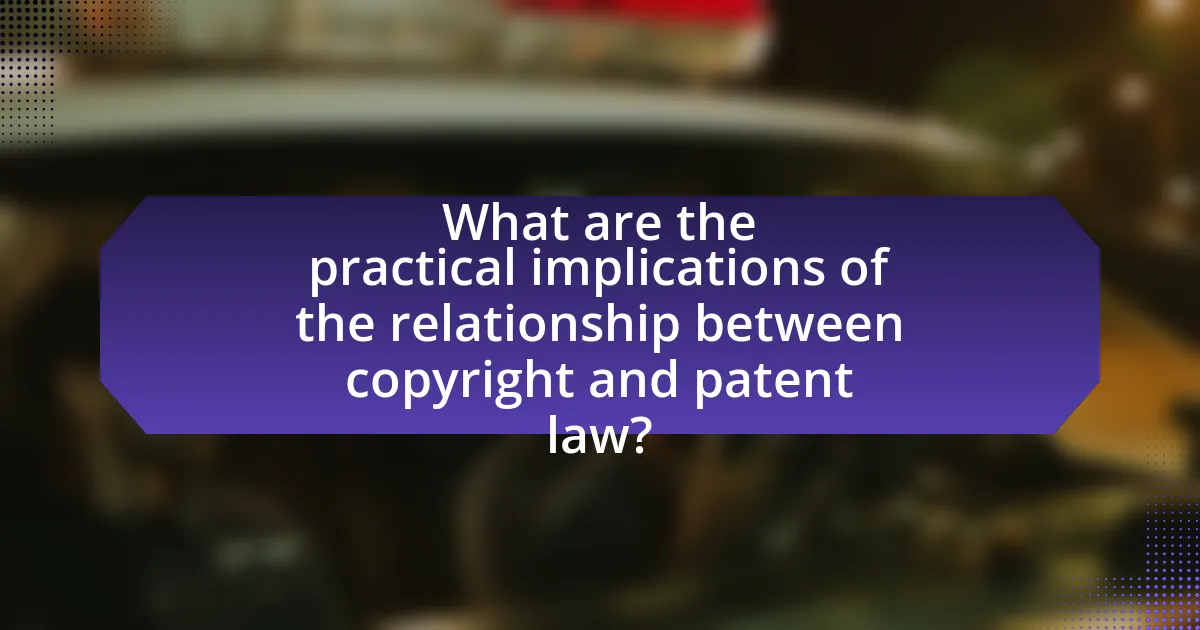
What are the practical implications of the relationship between copyright and patent law?
The practical implications of the relationship between copyright and patent law include the potential for overlapping protections and the necessity for creators to navigate both legal frameworks. Copyright protects original works of authorship, such as literature and music, while patents protect inventions and processes. This overlap can lead to complexities in licensing, as a single product may be subject to both copyright and patent protections. For instance, a software program may be copyrighted for its code while also being patented for its unique algorithm. This duality necessitates careful consideration by creators and businesses to ensure compliance with both laws, as failure to do so can result in legal disputes or loss of rights. Additionally, the relationship influences innovation, as creators may choose to pursue one form of protection over the other based on the nature of their work and market strategy.
How can creators navigate copyright and patent protections effectively?
Creators can navigate copyright and patent protections effectively by understanding the distinct legal frameworks governing each. Copyright protects original works of authorship, such as literature, music, and art, while patents protect inventions and processes. Creators should register their works with the U.S. Copyright Office or the relevant authority in their jurisdiction to establish ownership and gain legal recourse against infringement. For patents, filing an application with the U.S. Patent and Trademark Office is essential to secure exclusive rights to an invention for a specified period, typically 20 years.
Additionally, creators should conduct thorough research to ensure their work does not infringe on existing copyrights or patents, as this can lead to costly legal disputes. Utilizing legal resources, such as consulting with intellectual property attorneys, can provide tailored guidance on protecting their creations. According to the U.S. Copyright Office, registration not only provides legal advantages but also serves as a public record of ownership, reinforcing the creator’s rights.
What strategies can be employed to secure both copyright and patent rights?
To secure both copyright and patent rights, individuals and organizations should employ a dual strategy that includes timely registration and comprehensive documentation. Timely registration of patents with the United States Patent and Trademark Office (USPTO) ensures legal protection for inventions, while copyright registration with the U.S. Copyright Office protects original works of authorship. Comprehensive documentation, including detailed records of the creation process and development stages, strengthens claims for both rights. This approach is supported by the fact that registered copyrights and patents provide legal presumptions of ownership, making enforcement against infringement more effective.
What common pitfalls should creators avoid when dealing with these laws?
Creators should avoid the pitfall of misunderstanding the distinct protections offered by copyright and patent law. Copyright protects original works of authorship, such as literature and art, while patents protect inventions and processes. Failing to recognize this difference can lead to inadequate protection of their intellectual property. Additionally, creators should avoid assuming that registration is unnecessary; for patents, filing is essential to secure rights, and for copyright, while registration is not mandatory, it provides legal advantages in enforcement. Lastly, creators must not overlook the importance of licensing agreements, as improper licensing can result in loss of rights or legal disputes.
What resources are available for understanding copyright and patent law?
Resources available for understanding copyright and patent law include government websites, legal textbooks, online courses, and academic journals. The United States Patent and Trademark Office (USPTO) provides comprehensive guides and resources on patent law, while the U.S. Copyright Office offers detailed information on copyright law. Legal textbooks such as “Copyright Law” by Paul Goldstein and “Patent Law” by Janice M. Mueller serve as authoritative references. Online platforms like Coursera and edX offer courses on intellectual property law, which cover both copyright and patent aspects. Academic journals, such as the “Harvard Law Review” and “Journal of Intellectual Property Law,” publish articles and case studies that analyze current issues and developments in copyright and patent law.
Where can individuals find legal assistance for copyright and patent issues?
Individuals can find legal assistance for copyright and patent issues through specialized law firms, legal aid organizations, and online legal services. Specialized law firms often have attorneys who focus on intellectual property law, providing tailored advice and representation. Legal aid organizations may offer free or low-cost services to individuals who qualify based on income. Online legal services, such as LegalZoom or Rocket Lawyer, provide accessible resources and consultations for those seeking assistance with copyright and patent matters.
What educational materials can help deepen understanding of these laws?
Textbooks on intellectual property law, such as “Intellectual Property Law: Text, Cases, and Materials” by Tanya Aplin and Jennifer Davis, provide comprehensive insights into the relationship between copyright and patent law. These textbooks cover fundamental concepts, case studies, and legal frameworks that illustrate how copyright and patent laws interact. Additionally, online courses offered by platforms like Coursera or edX, focusing on intellectual property, can enhance understanding through structured learning and expert lectures. Legal journals, such as the “Harvard Law Review,” often publish articles analyzing recent developments in copyright and patent law, offering current perspectives and case analyses that deepen comprehension of these laws.
